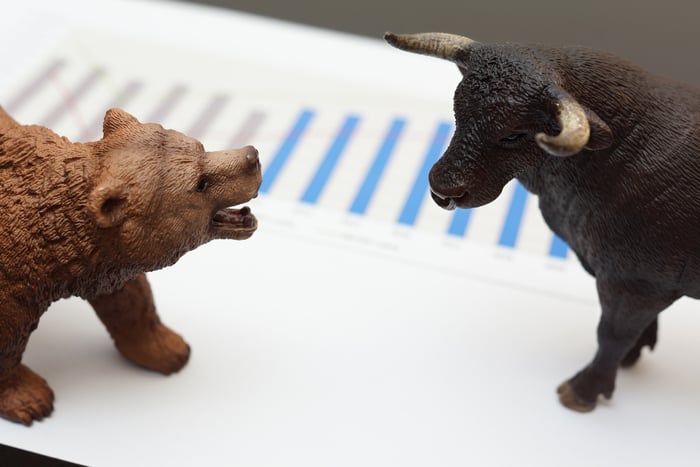One of the few constants Wall Street offers investors is short-term unpredictability. Since this decade began, the iconic Dow Jones Industrial Average (^DJI 0.40%), widely followed S&P 500 (^GSPC 1.02%), and growth-driven Nasdaq Composite (^IXIC 2.02%) have swung like a pendulum, alternating bear and bull markets.
Although 2023 has been a considerably better year for investors, they're still left with one key question unanswered: What's next for the stock market?
While there's not an economic datapoint or predictive tool that can, with 100% accuracy, forecast short-term directional movements in the Dow Jones, S&P 500, and Nasdaq Composite, there is an assortment of metrics that have, historically, strongly correlated with moves in the broader market. One of these strongly correlated metrics made history this past week, and it provides a very clear outlook for what's expected to happen next for stocks.

Image source: Getty Images.
We're witnessing history -- and it may spell trouble for Wall Street
Since this year began, I've combed through a number of economic datapoints and predictive tools that either portend trouble for Wall Street or forecast greener pastures for equities. But few of these datapoints and predictive indicators possess the gravity of this week's metric of focus: commercial bank credit.
Commercial bank credit is a weekly reported figure by the Board of Governors of the Federal Reserve System that allows the public to see how much, in aggregate, U.S. commercial banks hold in various loans, leases, and Treasury/agency securities (e.g., mortgage-backed securities). As of Sept. 15, 2023, commercial bank credit stood at $17.237 trillion.
To be brutally honest, it's not a figure most investors or even economists are going to pay much attention to. The reason being that commercial bank lending has been climbing at an almost uninterrupted pace for five decades. Since reporting began at the start of 1973, aggregate commercial bank credit has grown by a little over 7% on an annualized basis.
The reason commercial bank lending rises with such consistency is twofold. First, banks are incented to lend to cover the costs of taking in deposits, such as any interest paid on the deposits they hold. Within reason, banks are always looking to safely write loans to generate interest income above and beyond their interest-related expenses.
The other factor that drives commercial bank credit higher over time is the natural expansion of the U.S. economy. Even though recessions are a normal and inevitable part of the economic cycle, periods of economic expansion last considerably longer. As the U.S. economy grows, the ability of banks to lend grows with it.
US Commercial Banks Bank Credit data by YCharts.
There have, however, been rare instances over the past 50 years when commercial bank lending has declined. While minor dips of less than 1% have happened a number of times over the past half-century, there are only four instances when commercial bank credit has fallen by at least 1.5% from its all-time high. Even rarer are the three instances when commercial bank credit has dipped by at least 2%.
Last week, commercial bank credit hit its lowest level of 2023 -- precisely 2% below its all-time high, set on Feb. 15, 2023. Only the peak decline of 2.09% during the dot-com bubble in October 2001, and the 6.94% maximum drop following the financial crisis in March 2010, have involved a larger retracement.
There are two seemingly definitive takeaways from this historic decline. First, it signals, without a doubt, that U.S. commercial banks are tightening their lending standards. While the quarterly published Senior Loan Officer Survey on Bank Lending Practices from the Board of Governors of the Federal Reserve already alluded to commercial bank tightening, the hard data clearly shows that banks aren't as willing to lend. For businesses, it means less opportunity to borrow with the intent of hiring, innovating, and acquiring other businesses.
The other takeaway is what fewer available dollars for lending does to the stock market. In the three previous instances when commercial bank credit declined by at least 1.5%, the S&P 500 lost in the neighborhood of half of its value. While this isn't to say history will repeat itself in terms of the magnitude of the decline, it does suggest tighter lending practices are likely to weigh on corporate earnings and push the Dow Jones, S&P 500, and Nasdaq Composite lower in the coming quarters.

Image source: Getty Images.
Perspective is everything on Wall Street
Given how much the major indexes have rallied off of their 2022 bear-market lows, this probably isn't the outcome you expected. But when investing on Wall Street, perspective is everything.
There's little question that stocks are facing a very challenging next couple of quarters. In addition to banks tightening their lending practices, stock valuations are historically high (based on the Shiller price-to-earnings ratio), M2 money supply has meaningfully declined from July 2022, and a sizable inversion of the yield curve usually spells trouble for the economy.
But if your investment horizon extends beyond the next 18 to 24 months, history shows there's probably not much to worry about.
US Commercial Banks Bank Credit data by YCharts.
For example, let's change the perspective on commercial bank lending. While the previous chart examined declines in lending from an all-time high, the chart you see above is aggregate commercial bank credit since the start of 1973.
You'll notice that even those three "historic events" when commercial bank lending fell by at least 2% are nothing more than minor blips in what's been a relatively steady uptrend for a half-century. The American economy is going to continue growing over the long run, and bank lending will be climbing right along with it. That bodes well for an increase in corporate earnings over multiple decades.
Data from Bank of America Global Research offers compelling evidence about the power of patience and perspective, as well.
Bank of America Global Research recently released a report examining the probability that an investor would generate negative returns, based on the length of their holding period, in relation to the total returns (including dividends paid) of the S&P 500 since the beginning of 1929. That's more than 94 years' worth of data.
What the report showed was a crystal-clear decline in the probability of negative returns the longer an investor held their position.

Data source: Bank of America Global Research. Chart by author.
For instance, history shows that you have about a 54% chance of making money by, hypothetically, holding an S&P 500 tracking index for one day. Comparatively, your probability of generating positive returns increases to 62% if you hold for a month, 68% for a quarter (three months), or 75% if held for a year.
A separate study by Crestmont Research that was back-tested to 1900 found that all 104 rolling 20-year periods they examined in the S&P 500 (1919 to 2022) would have produced a positive total return. Put another way, holding an S&P 500 tracking index for 20 years has, when back-tested, never failed to generate a profit for investors.
Could Wall Street be headed for a period of turbulence? Quite possibly. Just keep in mind that patience has a way of working out for investors in the end.






